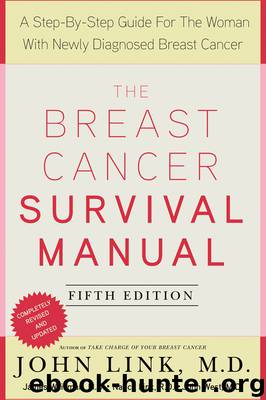The Breast Cancer Survival Manual, Fifth Edition by John Link M.D

Author:John Link, M.D.
Language: eng
Format: epub
Published: 2019-05-04T16:00:00+00:00
1
Breast Cancer Basics
can•cer noun \’kan(t)-s r\ : a malignant tumor of potentially unlimited growth that expands locally by invasion and systemically by metastasis
Before beginning our discussion about cancer of the breast, I want to give you some very basic information about cancer in general and how its unique characteristics compare to a normal cell.
Normal body cells can:
• Reproduce themselves EXACTLY
• Stop reproducing at the right moment
• Stick together in the correct place
• Self-destruct if a mistake occurs or they are damaged
• Mature and become specialized
• Die (they are programmed to do so), and when appropriate they are renewed by like cells
Cancer cells are different from normal cells in the following ways:
• Cancer cells don’t stop reproducing
• Cancer cells don’t obey signals from other cells
• Cancer cells don’t stick together; they can break off and float away
• Cancer cells stay immature and don’t specialize, so they become more and more primitive, and they reproduce quickly and haphazardly
• Cancers cells lose their programmed death pathway
In this chapter we are going to explore the nature of breast cancer. It is a mystery to us why the female breast is vulnerable to developing cancer. It may have something to do with monthly cycling of glandular cells, yet more than half of breast cancers develop in older women after the breast glands have come to rest. We know that cancer tends to occur in organs with cells that are constantly cycling through cell renewal. The replacement of a cell requires the production of a new set of genes, and this process can lead to mistakes ( mutations) that the cell is unable to repair. The mistakes can then be repeated, causing a cell to grow according to a new blueprint in a process that is out of control, and this process results in cancer.
First, let’s examine the anatomy of the female breast ( Figure 1.1). The female breast is composed of milk-producing lobules connected to milk ducts that carry milk from the lobule to the nipple. There are at least twelve or more of these separate branching ductal-lobular units that occupy the four quadrants of the breast. Supporting and surrounding the glandular units are fibrous tissue, fat cells, blood vessels, and the lymphatic system that drains from the breast to the lymph nodes. We believe that the majority of breast cancers are due to a genetic mistake within the cells lining the lobules or ducts. There is evidence that genetic mistakes are common, and the majority are harmless. Cells actually have the ability to self-repair these genetic mistakes so that they do not go on to become cancer.
A cancer is born when a mistake occurs at a critical point in the cell’s genetic blueprint, or DNA, and it goes unrepaired. This genetic mistake affects the behavior and characteristics of the affected cell and the new cells that are produced. When a cell becomes genetically unstable, it has gone bad. These unstable cells continue to divide, passing along the damaged or mutant genetic message to the next generation of cells.
Download
This site does not store any files on its server. We only index and link to content provided by other sites. Please contact the content providers to delete copyright contents if any and email us, we'll remove relevant links or contents immediately.
Men In Love by Nancy Friday(4974)
Everything Happens for a Reason by Kate Bowler(4485)
The Immortal Life of Henrietta Lacks by Rebecca Skloot(4269)
Why We Sleep by Matthew Walker(4202)
The Sports Rules Book by Human Kinetics(4086)
Not a Diet Book by James Smith(3161)
The Emperor of All Maladies: A Biography of Cancer by Siddhartha Mukherjee(2939)
Sapiens and Homo Deus by Yuval Noah Harari(2858)
Day by Elie Wiesel(2602)
Angels in America by Tony Kushner(2397)
Endless Forms Most Beautiful by Sean B. Carroll(2356)
A Burst of Light by Audre Lorde(2355)
Hashimoto's Protocol by Izabella Wentz PharmD(2209)
Dirty Genes by Ben Lynch(2169)
Reservoir 13 by Jon McGregor(2152)
And the Band Played On by Randy Shilts(2023)
Wonder by R J Palacio(1998)
The Immune System Recovery Plan by Susan Blum(1974)
Stretching to Stay Young by Jessica Matthews(1951)
